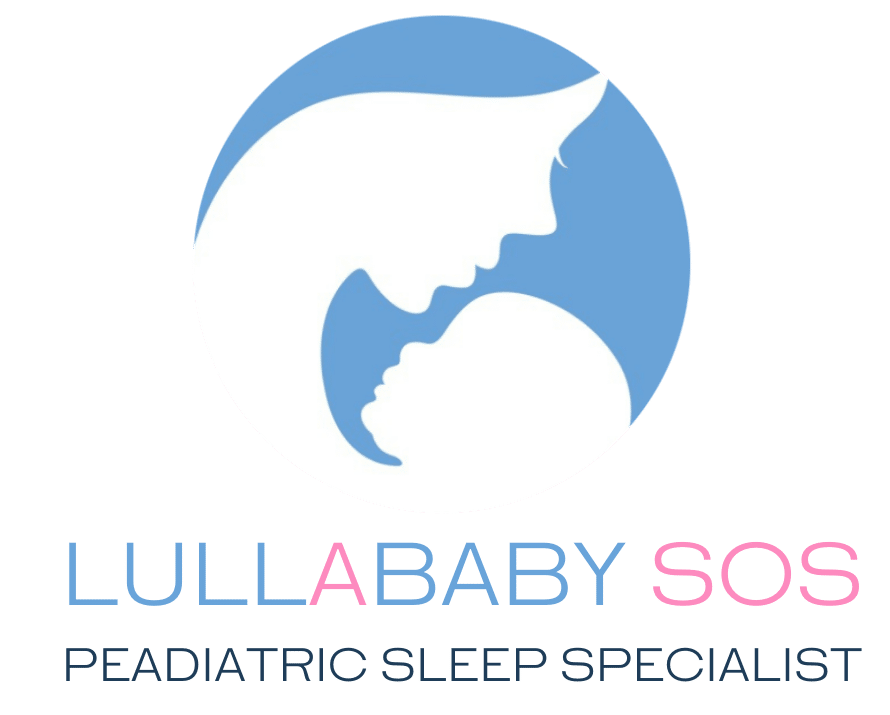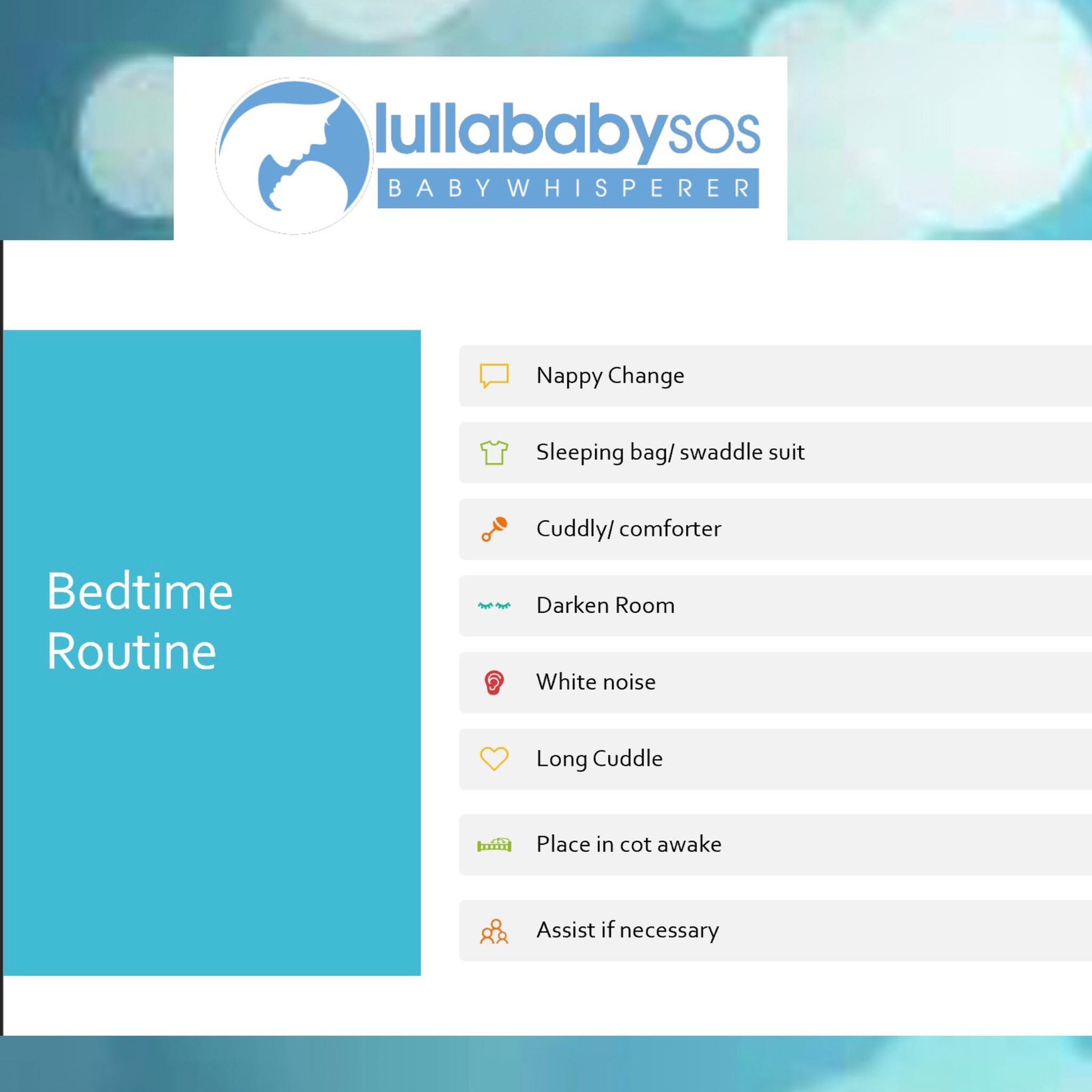BEDTIME ROUTINE
Having a consistent bedtime routine for both daytime naps and nighttime sleeps is an important factor for a baby successfully learning how to sleep. A step-by-step consistent routine helps babies understand when it’s sleep time.
It also helps promote positive sleep associations and can trigger melatonin production in the evening. (melatonin is the body’s natural sleep hormone that is produced in the evening and in the dark)
Starting a bedtime routine from very early on helps sleep and settling skills develop naturally and positively.
It’s important to create a bedtime routine that works for your family, and that has the same sequence of steps each time to help your baby learn the process to of winding down before sleep
Lulla-baby Sos recommends following the steps every time you’re prepping your baby for bed
NAPPY CHANGE – I recommend that you change your nappy every time before a nap, night-time sleep or after feeding overnight time. Even if your baby doesn’t need a nappy change, I will generally pretend to change it for them so that this helps to get the start of the bedtime routine.
SLEEPING BAG OR SWADDLE SUIT-
Lulla-baby SOS recommends that you use your sleeping bag or swaddle suit for both daytime and nighttime sleeps again this helps trigger to your little that they’re going to bed. A sleeping bag is a long-term positive sleep association. Babies under four months of age have a very strong Moro reflex, and as a general rule, they feel comforted by being swaddled for all sleeps. Swaddling replicates the feeling of the tight, confined place of being in the womb. Very young babies have also little to no control over their limbs and as they get tired the sporadic movements of their limbs can cause them to become more irritable and can wake them during sleeps. Between three and five months I recommend transitioning into a sleeping bag this sends very strong cues to your baby that they’re going to sleep not into another play area.
Babies cannot keep blankets on or control their temperature until around 2.5 years. This is another reason that I recommend using sleeping bags throughout the seasons so that you don’t struggle to get them into heavier weight sleeping bag in the cooler months.
OFFER A CUDDLE OR COMFORTER-
Having a cuddly or a comforter your baby associates with Sleep sends very strong cues to them that it’s sleep time. Lullababy SOS recommends that you choose a comforter that is age-appropriate, safe, breathable (natural fibres such as bamboo and cotton), washable and replaceable. To help form a positive relationship with this comforter, use it often and during awake times, keeping it close to you during feeds and cuddles. Once the relationship has been formed with this comforter it can be transitioned to only bedtimes.
Remove all items from you can’t that are not conducive to sleep. Any extra bedding toys mobiles should be removed from the cot before sleep. Here’s a link to SIDS recommended guidelines.
DARKEN ROOM-darkness helps produce melatonin; melatonin is the sleep onset hormone. Early on, babies have no circadian rhythm to help develop this circadian rhythm we need to create an environment that’s conducive to sleep. At the beginning of all naps and night sleeps we should make the environment darker to help promote the production of melatonin. By around three months of age you should notice that your baby is sleeping for a longer block at the beginning of the night as this is when melatonin production is the strongest overnight it decreases and early in the morning, it is at its lowest point. Parents will be surprised at how overstimulated babies can get with even the smallest amount of light. For babies who are very sensitive or in environments like Queensland where it is getting light from 4 am in the morning in summer, I recommend using block-out blinds to block out as much light coming into the room as possible. Check out MY BLOCKOUT BLINDSfor awesome portable block out blinds.
WHITE NOISE -Young babies are used to a very noisy woman and find it difficult to settle in silence. White noise earlier on can help mimic the worm and be extremely soothing to your little one. As they get older using white noise to help block out external interruptions During nap times and nighttime sleeps. You don’t necessarily need to use just white noise you anything that has a constant with make noise is perfect. I recommend two apps, and you can use these from the free versions. The thing I love about both of these apps is that you can blend will more than one tune together.
Here are the links:
White Noise Deep Sleep Sounds by Kitefaster
https://apps.apple.com/au/
and Relax Melodies: Sleep Sounds by Ipnos Software Inc.
https://apps.apple.com/au/
LONG CUDDLE WITH SHUSH / SWAY –
This final cuddle just helps to trigger tiredness and prepare them to be placed in the crib.
You should make sure that you put your baby into the crib, ready for sleep but awake.
PATTING JIGGLING or TAPPING –
If your baby is needing some support extra support to go to sleep you should use some gentle patting, jiggling or tapping movement that mimics the womb or how you comfort them in your arms to support them in that final wind down to sleep it’s important to do this in the cot.
As your baby becomes more familiar with the term routine and your lead-up to bedtime, they will find it easier to wind down and become more confident in their self-settling ability.




